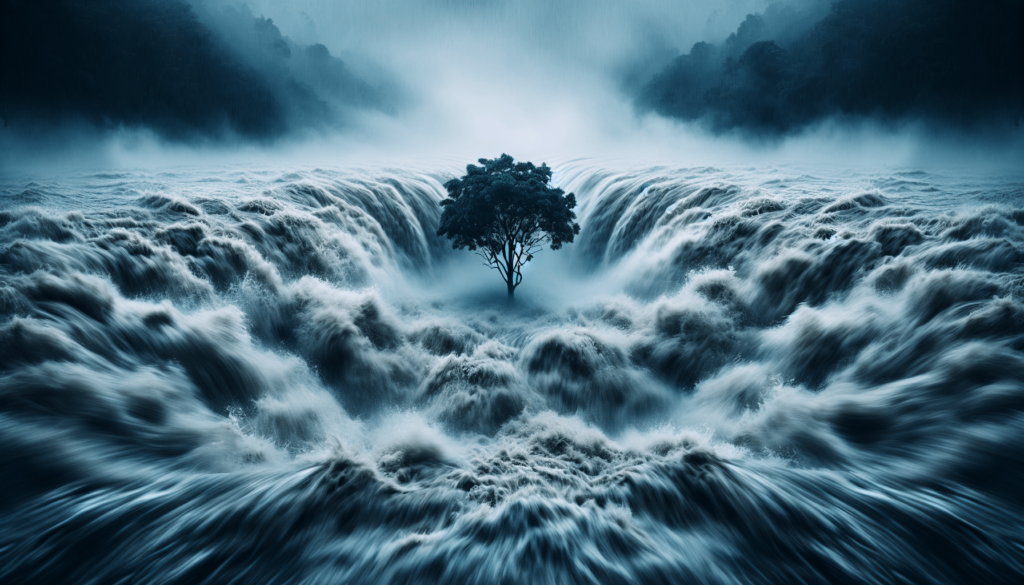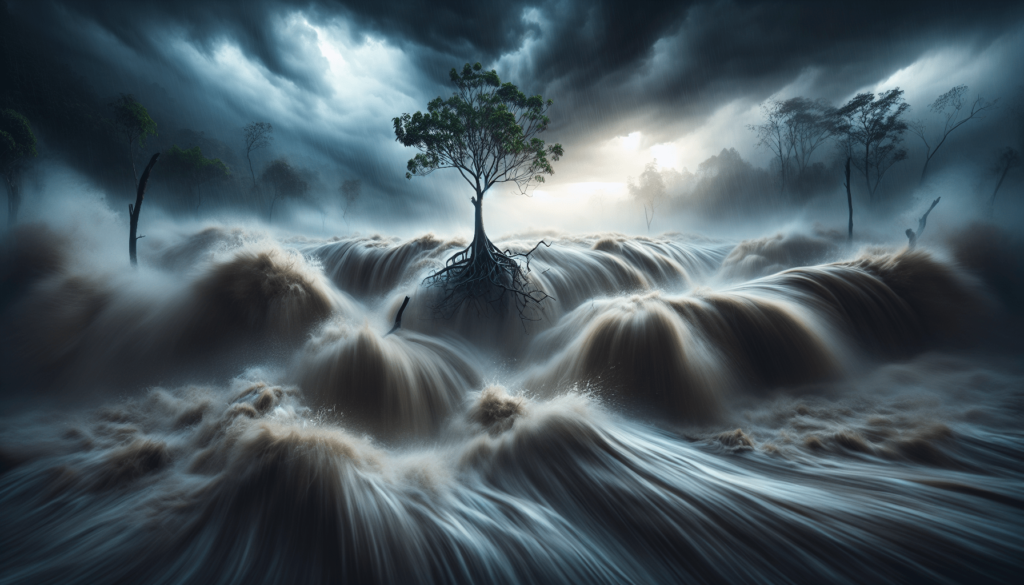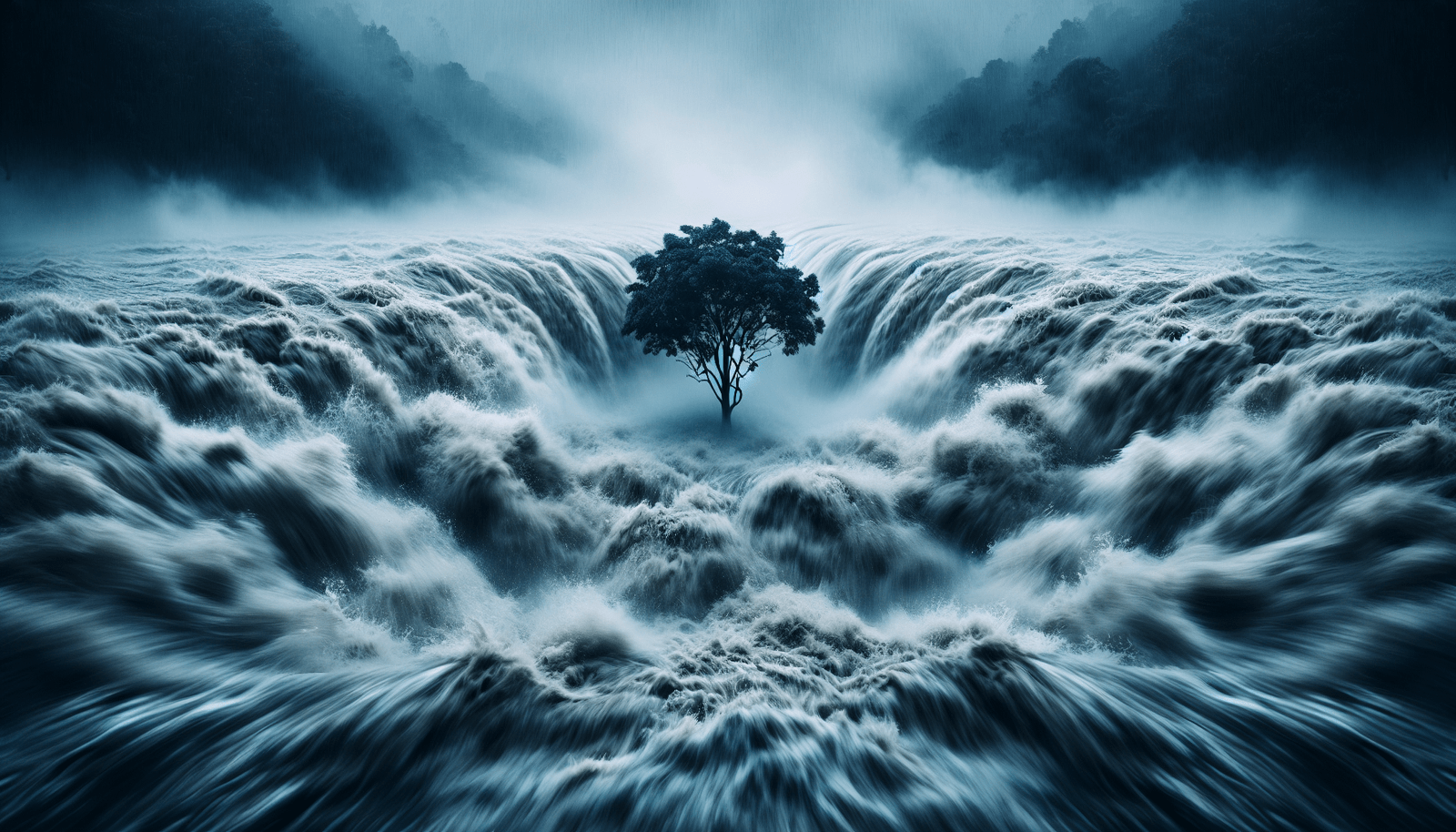Are you a thrill-seeker itching to explore the great outdoors? Or perhaps you’re someone who wants to be prepared for any situation that may arise? Look no further than the realm of wilderness survival skills. From starting a fire to finding food and water, mastering these techniques can mean the difference between a thrilling adventure and a perilous predicament. That’s where “The Survivalist Handbook” comes in. Our blog is dedicated to equipping you with the knowledge you need to thrive in any wilderness environment. Under our “Wilderness Survival” category, find a comprehensive array of articles covering essential skills, specific threats, and various scenarios. Brace yourself for the challenge and learn how to conquer flash floods with our wilderness survival tactics.
Understanding Flash Floods
What is a flash flood?
A flash flood is a sudden and powerful flood that occurs within a short period of time, typically within six hours of heavy rainfall or another intense water-related event. Unlike slow-rising floods, flash floods are characterized by their rapid onset and swift-moving waters. They can be incredibly dangerous and have the potential to cause significant damage to both property and human life.
Causes of flash floods
Flash floods can be caused by a variety of factors, including heavy rain, thunderstorms, hurricanes, or dam failures. In mountainous areas, flash floods can occur as a result of the rapid melting of snow or ice. Urban areas are particularly susceptible to flash floods due to the large amount of paved surfaces that prevent water from being absorbed into the ground. Instead, the water quickly accumulates and overwhelms drainage systems, leading to sudden and devastating floods.
Signs of an approaching flash flood
Being able to recognize the signs of an approaching flash flood is crucial for your safety. Look out for rapidly rising water levels, intense rainfall, or sudden changes in water clarity. Keep an eye on weather reports and pay attention to any flood warnings or advisories issued by local authorities. Remember that flash floods can occur even in areas where it is not currently raining, as the floodwaters may be flowing downstream from a different location.
Preparing for Flash Floods
Research and map the area
Before venturing into an area prone to flash floods, it is essential to research and map the region thoroughly. Identify any potential flash flood zones, rivers, or streams that might pose a risk. Familiarize yourself with evacuation routes and emergency shelters in the area. Knowing the topography of the land and studying past flood events can provide valuable insights into the potential dangers you may face.
Check weather forecasts
Staying informed about the weather conditions in your area is crucial when it comes to preparing for flash floods. Regularly check weather forecasts, especially during periods of heavy rainfall or when there is a chance of thunderstorms. Be aware of any flash flood watches or warnings issued by meteorological agencies. Familiarize yourself with the difference between a watch, which means that conditions are favorable for a flash flood, and a warning, which means a flash flood is imminent or already occurring.
Pack necessary survival gear
Having the right survival gear can make a significant difference in your ability to withstand a flash flood. Essential items to include in your pack are a waterproof flashlight, extra batteries, a first-aid kit, a whistle, a multi-tool, waterproof matches, and a protective poncho. Additionally, pack non-perishable food, water purification tablets, a map and compass, and extra clothing. Consider bringing a portable emergency radio to stay updated on weather conditions and potential rescue efforts.

Surviving a Flash Flood
Stay informed and vigilant
During a flash flood, it is crucial to stay informed and vigilant. Monitor weather updates and flood warnings to stay in the know. If you encounter heavy rainfall or rising water levels, remain alert and aware of your surroundings. Keep an eye out for debris being carried by the floodwaters, as it can cause injury or block your path. Stay away from bridges, tunnels, and areas where water is flowing rapidly, as they can be extremely dangerous.
Seek higher ground
When faced with a flash flood, your immediate priority should be to seek higher ground. Move to elevated areas such as hills, ridges, or buildings on higher ground. Avoid basements or ground-level areas altogether, as they are most vulnerable to flooding. If you find yourself in a vehicle, abandon it immediately and seek higher ground on foot. Remember that flash floods can occur rapidly, so act quickly and do not underestimate the power of moving water.
Avoid floodwaters
Do everything possible to avoid entering floodwaters. Even relatively shallow floodwaters can be deceptively strong and capable of sweeping you off your feet. Avoid walking or driving through flooded areas, as you may encounter unseen hazards or be caught in a dangerous current. If you must cross a flooded area, use a sturdy stick or pole to check the depth and stability of the ground before proceeding. It is always best to err on the side of caution and find an alternative route.
Beware of secondary hazards
Flash floods can bring about additional hazards beyond the immediate threat of rising water. Be aware of potential secondary hazards such as landslides, falling trees, or electrical hazards. Heavy rainfall can destabilize the ground, leading to landslides or mudslides. Steer clear of areas with loose soil or steep slopes. Be cautious of trees that may be uprooted or weakened by the floodwaters, as they can pose a significant risk. Additionally, be mindful of any downed power lines or submerged electrical equipment.
Building Shelter and Finding Water
Building a debris shelter
Finding or building shelter is vital during a flash flood. In emergency situations, a debris shelter can provide temporary protection from the elements. Look for large stable materials such as fallen trees, branches, or rocks to create a framework for your shelter. Cover the framework with smaller branches, leaves, or any available debris to provide insulation and protection from wind and rain. It is essential to construct your shelter on higher ground, away from potential flood zones.
Finding safe water sources
Access to safe drinking water is crucial in any survival situation. During a flash flood, contamination of water sources is a significant concern. Avoid drinking floodwaters, as they are likely to be contaminated with debris, bacteria, and other pollutants. Instead, look for natural sources such as springs, streams, or rivers that are not directly affected by the flood. Remember to purify the water before consumption to eliminate any potential pathogens or contaminants.
Purifying water for consumption
purifying water is essential to prevent waterborne illnesses. Boiling is the most reliable method of water purification. If you have access to fire and a container, boil water vigorously for at least one minute to kill any pathogens. If boiling is not an option, consider using water purification tablets or a portable water filter. These methods effectively remove or neutralize most microorganisms, ensuring the water is safe for consumption.

Creating Fire and Staying Warm
Gathering firewood in wet conditions
Starting a fire in wet conditions can be challenging but not impossible. Before attempting to locate firewood, gather materials that will help you start the fire, such as dry leaves, pine needles, or birch bark. Search for firewood in elevated areas, such as tree branches that are off the ground or standing deadwood. Split larger logs to access the dry interior wood. Remember to collect more firewood than you think you will need to ensure a sustainable heat source throughout the night.
Building a fire in the rain
Building a fire in the rain requires some ingenuity and preparation. Look for a natural windbreak, such as a large rock or a fallen tree, to shield the fire from rain and wind. Create a solid base by arranging rocks or building a platform with logs and branches. Use your dry fire-starting materials and small, dry tinder to get the fire going. Place larger logs or branches strategically to protect the flames from the rain. Once established, maintain the fire by adding dry fuel gradually.
Using fire for warmth and signaling
Fire serves multiple purposes during a flash flood situation. Besides providing warmth, a fire can also be used to signal for help. Position your fire in an open area that maximizes its visibility, especially at night. Create a smoky fire by burning green vegetation or damp materials, which will produce thick smoke that can be seen from a distance by potential rescuers. Remember to always prioritize your safety and conserve your firewood, as it may be your only source of heat.
Food and Foraging
Identifying edible plants and insects
Knowing how to identify edible plants and insects is vital for sustaining yourself during a flash flood situation. Familiarize yourself with the edible plant species in your local area, focusing on those that are abundant and easy to identify. Learn to differentiate between edible and poisonous plants and ensure you have a field guide or reliable resource with you. Insects can also provide a valuable source of protein, so educate yourself on which insects are safe to consume.
Fishing and trapping techniques
If you are near a water source, fishing can be an effective way to obtain food during a flash flood. Learn basic fishing techniques, such as using a basic fishing line or crafting a makeshift fishing net. You can fashion a hook from available materials or use natural bait such as insects or small pieces of food. Additionally, consider setting up traps or snares to catch small game animals. Research different trapping methods and understand the local wildlife to increase your chances of a successful catch.
Preservation and cooking methods
Preserving and cooking your food properly is essential to prevent spoilage and ensure it is safe to eat. If you have access to fire, cooking your food can help kill any bacteria or parasites. Ensure that all meat is thoroughly cooked to eliminate pathogens. If you catch fish or find edible plants, consume them as soon as possible to maximize freshness. If you have excess food, consider drying or smoking it for long-term preservation. Proper preservation methods can significantly extend the shelf life of your food supply.
Navigating in a Flooded Environment
Understanding water currents
Understanding water currents is crucial when navigating through a flooded environment. Avoid crossing fast-moving water, as even a shallow stream can exert enough force to sweep you off your feet. Instead, look for slower-moving water that appears calmer and less turbulent. Avoid areas with debris or obstacles that can trap or injure you. It is also essential to be aware of the power of undertows or whirlpools, as they can pull you underwater or drag you downstream.
Using makeshift rafts or debris boats
In some cases, using a makeshift raft or debris boat can assist you in navigating floodwaters. Look for large, buoyant objects such as fallen trees or floating debris that can be used as a base for your raft. Secure additional debris to serve as oars or paddles. Test the stability of the raft before using it and ensure that you have a means to control its direction. Exercise caution when using makeshift rafts, as they may not be entirely reliable in treacherous water conditions.
Using natural markers for navigation
Navigating in a flooded environment can be disorienting, but using natural markers can help you maintain a sense of direction. Look for high-ground features such as hilltops, ridges, or distinctive trees that can act as landmarks. Take note of the direction of the current to avoid traveling in circles. Use the sun’s position or the moon’s phase to determine cardinal directions if needed. If you have a map and compass, refer to them to maintain a steady course and ensure you are moving towards safety.
Communication and Rescue
Signaling for help
In a flash flood situation, getting help and alerting rescuers to your location is vital. You can signal for help using visual signals such as mirrors, flashlights, or brightly colored clothing. Create a signal fire by placing green vegetation or damp materials on your fire to produce thick smoke. Use a whistle or other loud noise-making devices to attract attention. If possible, construct an SOS sign from rocks or logs on open ground. Remember to remain visible and maintain your position until help arrives.
Building distress signals
Building conspicuous distress signals can significantly increase your chances of being rescued. Create a visible SOS sign on the ground using rocks, logs, or any other materials that contrast with the surrounding area. Arrange the markers in a way that can be easily recognized from the air or by ground search teams. Consider utilizing brightly colored objects or signaling flags to attract attention. Maintain and update your distress signals regularly to indicate that you are still in need of assistance.
Survival radio and communication devices
Carrying a survival radio or other communication devices can greatly enhance your chances of rescue during a flash flood. Portable radios with weather band capabilities allow you to stay updated on changing weather conditions and receive important emergency broadcasts. In addition, personal locator beacons (PLBs) or satellite messengers can transmit your exact location to emergency responders. It is essential to familiarize yourself with the operation of these devices before an emergency situation arises.
Mental and Emotional Preparedness
Managing fear and anxiety
Flash floods can be incredibly stressful and induce fear and anxiety. It is crucial to manage these emotions to remain calm and focused during an emergency. Take deep breaths and focus on positive thoughts to help alleviate fear. Remind yourself that you have the skills and knowledge necessary to overcome the situation. Engage in relaxation techniques, such as meditation or visualization exercises, to reduce anxiety. Maintain a positive mindset and remind yourself that you can overcome the challenges you are facing.
Staying calm and focused
Staying calm and focused is essential in any survival situation. Take a moment to assess your surroundings and formulate a plan of action. Prioritize your needs and focus on executing one task at a time. Avoid rushing or making impulsive decisions that could jeopardize your safety. Remember to stay flexible and adaptable, as circumstances may change rapidly during a flash flood. Maintain a positive mindset and use your training and skills to navigate the challenges ahead.
Maintaining morale in difficult situations
Keeping morale high during a flash flood can be challenging, but it is crucial for your overall well-being and survival. Find ways to stay positive and maintain a sense of hope. Engage in activities that bring you joy and distract from the difficult circumstances. Share stories or jokes with fellow survivors to foster a sense of camaraderie. Celebrate small victories and milestones, no matter how insignificant they may seem. Remember that maintaining morale can help you endure the challenges and increase your chances of survival.
Training and Practice
Participating in wilderness survival courses
Enrolling in wilderness survival courses is an excellent way to gain hands-on experience and knowledge. Look for courses that specifically cover survival tactics for flash floods or similar water-related emergencies. These courses often provide practical training in navigation, foraging, building shelter, and other essential skills. They also offer opportunities to practice decision-making and problem-solving in realistic scenarios. By actively participating in these courses, you can develop the confidence and competence needed to thrive in flash flood situations.
Practicing survival skills regularly
Regular practice is key to maintaining proficiency in survival skills. Set aside time to practice building shelters, starting fires, purifying water, and navigating through different environments. Practice your signaling techniques and familiarize yourself with using survival tools and equipment. Regular practice not only enhances your muscle memory but also builds confidence and helps you identify areas that may require improvement. Make survival drills a routine part of your outdoor activities to ensure you stay prepared for emergencies.
Mock survival scenarios
Conducting mock survival scenarios is an effective way to put your skills and knowledge to the test. Create hypothetical scenarios that simulate flash flood situations and work through them step by step. Practice making decisions under pressure and adapting to changing circumstances. Consider involving friends or family members to simulate a group survival environment. Mock scenarios allow you to identify strengths and weaknesses, refine your techniques, and build resilience in the face of adversity.
In conclusion, understanding flash floods and being prepared for their potential dangers is crucial for anyone venturing into the wilderness. By researching the area, checking weather forecasts, and packing necessary survival gear, you can significantly increase your chances of survival during a flash flood. In the event of a flash flood, staying informed, seeking higher ground, avoiding floodwaters, and being aware of secondary hazards are essential survival tactics. Building shelter, finding safe water sources, creating fire, and foraging for food become vital for long-term survival. Navigating in a flooded environment, using communication and distress signals, and maintaining mental and emotional preparedness are also crucial skills. Finally, continuous training, regular practice, and conducting mock survival scenarios ensure that you are always prepared for the challenges that flash floods may bring. Stay safe, stay prepared, and conquer flash floods with confidence.

